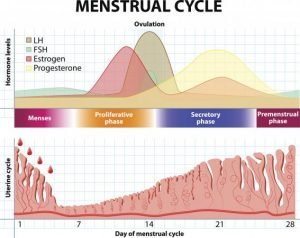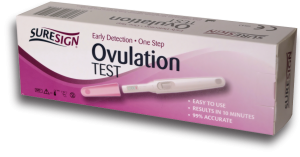 Why is it easy to get pregnant for one representative of the fair sex and so difficult for another one? Let us turn to physiology. A woman in reproductive age has ovulation every month around the middle of the cycle. This term is understood as the exit of a mature ovum from the ovary. This process takes only 1-2 days.
Why is it easy to get pregnant for one representative of the fair sex and so difficult for another one? Let us turn to physiology. A woman in reproductive age has ovulation every month around the middle of the cycle. This term is understood as the exit of a mature ovum from the ovary. This process takes only 1-2 days.
Many people, after reading the text written above, probably will think that it’s very simple to get pregnant – you just need to calculate the day of ovulation and have sex before and after it. However, everything is not as simple as it seems. If you could get pregnant strictly in the middle of the cycle, there would be no unwanted pregnancies and women who dream about a child but cannot become pregnant for some reason.
Contents
- Method number 1: Use calendar to calculate your safe days
- Method number 2: Analyze your menstrual cycle
- Method number 3: Measure basal temperature
- Method number 4: Do ovulation tests
- Method number 5: Have the ultrasound examination
- Method number 6: Listen to your body
- Top-6 Myths about chances to become pregnant
- Video
Method number 1: Use calendar to calculate your safe days
 Women who use the calendar method of contraception and refuse other means of protection (condoms, various birth control pills), don’t have 100% guarantee of not becoming pregnant as there are no absolutely safe days. You can get pregnant any time. It is necessary to take into account that there are days, when you have higher chances to become pregnant and the days when the chances are significantly reduced. There are no periods with zero probability.
Women who use the calendar method of contraception and refuse other means of protection (condoms, various birth control pills), don’t have 100% guarantee of not becoming pregnant as there are no absolutely safe days. You can get pregnant any time. It is necessary to take into account that there are days, when you have higher chances to become pregnant and the days when the chances are significantly reduced. There are no periods with zero probability.
Comparatively “safe” time can be considered a couple of days before the menstruation and a couple of days after this period.
With the 28-30-day menstrual cycle, the highest chances of conception occur on the 14-15th day because ovulation occurs during this period. There are also possible deviations for a number of reasons:
- due to nervous breakdowns,
- stresses,
- the presence of diseases,
- and the use of medications.
Important: To calculate the “dangerous” days, you need to know the length of the menstrual cycle. It must be stable – this is the main condition.
Back
Method number 2: Analyze your menstrual cycle
 Calculating the days in which you can conceive a child is not so easy. To do this, you need to analyze the entire menstrual cycle, taking the data for the past 6-12 months. If at that time you were using hormonal contraceptives, the results of the calculation may be incorrect.
Calculating the days in which you can conceive a child is not so easy. To do this, you need to analyze the entire menstrual cycle, taking the data for the past 6-12 months. If at that time you were using hormonal contraceptives, the results of the calculation may be incorrect.
To not forget on when you have menstruation usually, it is necessary to get a special calendar. If the menstrual cycle is not regular, then it will not work out. It is best in such cases to use other methods of calculating favorable periods for conception.
If there are minor deviations during the time interval under study, the following step-by-step calculation can be made:
- Select the longest and shortest menstrual cycles in 6-12 months.
- Subtract the number 18 from the number of days of a short cycle.
- The result obtained is the day from which the period with a high probability of becoming pregnant begins.
- Subtract the number 11 from the number of days of the longest period. The result is the day the period ends with a high probability of becoming pregnant.
Example: There is the shortest cycle is 25 days. Having subtracted 18, we get a total of 7. Hence, a favorable period for conception begins with the 7th day of the menstrual cycle.
Example: The longest cycle is 29 days. By subtracting 11, we get the number 18. Thus, on the 18th day of the menstrual cycle, a favorable period for conception ends.
Women usually want to know the answer to the question: “Is there any connection between the day of your cycle and the sex of the future kid?”
As you know, sperm consists of two types of sperm: “male” – y-spermatozoa (androsperm) and “female” – x-spermatozoids (gynesperma). The sex of the unborn child depends on how a sperm will be fertilized by a female ovum. The method of choosing sex is based on simple physiological facts:
- “Male” spermatozoa are more mobile, light, but less hardy;
- “Female” – on the contrary, slower, heavier, but also more durable, stable;
- Spermatozoa are able to live in the female reproductive tract up to 3 – 4 days;
- Conception can occur when the ovum moves along the fallopian tube to the uterus (that is, immediately after ovulation and within 3 to 4 days).
Based on these facts, the following assumptions are made: If the sexual intercourse occurred before ovulation, then “female” spermatozoa have more chances to survive to fertilization. And if the sexual intercourse occurred after ovulation, then the “male” spermatozoa have more chances of reaching the oocyte first. If the sexual intercourse has occurred less than a day before ovulation, then the quickest Y are the first to reach the goal. With a probability of up to 78 percent, it can be argued that a boy will be born. If the sexual intercourse occurred 25-36 hours before ovulation or a day or two after it, the Y chromosomes die. At the time of conception, the spermatozoa with the X chromosome remain near the egg. Therefore, the probability of conception of a girl is more than 71 percent.
Important: From the examples it can be seen that the greatest probability of getting pregnant is maintained between the 7th and the 18th day. As the day of ovulation approaches, the environment in the woman’s vagina becomes more alkaline, which is good for Y-spermatozoa. And 2-3 days before ovulation, the environment in the vagina has a more acidic reaction, which is favored by the more enduring X-spermatozoa (the Y-serotozoids do not survive).
Period number 1: Several days before menstruation
A single-valued answer to this question cannot be given. Conception may occur and may not happen. First, you should understand why the above question can be answered in the negative as well.
As you know, ovulation occurs in the middle of the cycle. Before the start of menstruation, the ovum dies. If ovulation occurs much later or repeatedly, pregnancy may not occur as the woman’s hormonal background will be set for a new cycle. Now let’s explain why conception may occur before menstruation.
The organism may respond to such a rare event with an unplanned ovulation. It can be provoked by substances contained in the sperm. Women who regularly have sex with a regular partner may not face this.
In healthy women leading an irregular sex life, the chance of getting pregnant is quite high. Conception may occur after any sexual intercourse.
Period number 2: During menstruation
Pregnancy during the first days of menstruation is unlikely. This is due to an unfavorable environment for spermatozoa and for the implantation of the embryo (abundant release of blood).
Conception in an unfavorable period may occur in the following cases:
- With prolonged menstruation (for example, before ovulation less than a week may remain and then the sperm will wait for the release of the matured ovum);
- Due to violations of the menstrual cycle, caused by diseases, infections, physical stress, stress;
- With an incorrect calculation of the period of safe sex (due to the irregularity of the menstrual cycle).
Important: However, “surprises” of nature should not be ruled out even it seems that you have calculated everything.
Period number 3: Several days after menstruation
Many representatives of the fair sex argue that within a few days after the end of menstruation it is impossible to become pregnant. Doctors do not adhere to this point of view. They warn that at any time you can get pregnant.
Spermatozoa getting into the female reproductive tract may remain viable and active for several days. If the menstrual cycle is short and the menstrual cycle is long, the probability of getting pregnant will be high. Sexual intercourse can take place during the most favorable days for conception.
Pregnancy immediately after menstruation may occur for the following reasons:
- Because of the ability of spermatozoa to remain active for several days;
- Due to maturation of several ovums in one menstrual cycle;
- Because of the change in the time of ovulation.
It may occur and not in the middle of the menstrual cycle, but much sooner or later.
Important: The so-called “culprit” of such violations in young girls is the irregularity of the menstrual cycle, and in adult women – hormonal abnormalities.
Top-4 Non-calendar methods to determine the greatest probability to become pregnant
You can calculate the most favorable days for conception not only with the help of the calendar method. There are several other more effective ways:
- Determination of basal temperature;
- Conducting tests for ovulation;
- Folliculometry;
- Subjective sensations.
Back
Method number 3: Measure basal temperature
 To calculate the period when the probability of conceiving a child is high, it is necessary to measure the basal temperature in the anus from the beginning of the menstrual cycle (from the 1st day of menstruation) every morning after awakening.
To calculate the period when the probability of conceiving a child is high, it is necessary to measure the basal temperature in the anus from the beginning of the menstrual cycle (from the 1st day of menstruation) every morning after awakening.
Errors can occur for several reasons:* Due to fatigue or illness (in such periods, the temperature is always increased);
- If a lot of alcohol was drunk before measurement;
- Due to taking some medications;
- If there was a sexual intercourse in 6 hours (or less) before the measurement;
- Because of lack of sleep.
Based on the measurement data, a schedule should be drawn up, which can be supplemented daily with new results. In the first half of the menstrual cycle, the temperature ranges from 36.6 to 36.9 degrees. It rises above 37 degrees after the release of a mature ovum.
To know when ovulation will come, you can by carefully studying of the schedule.
Important: On 12-16 days the basal temperature may slightly decrease. This will foreshadow the onset of ovulation in the next few hours. That’s when you can get pregnant. This period shouldn’t be missed by women who dream of a baby.
Back
Method number 4: Do ovulation tests
 Modern and more accurate means of determining the yield of an ovum – tests for ovulation. They even look like tests that you can use to find out about pregnancy. The result is shown in the form of 2 strips. The difference between the tests is only in the reagents. For example, in agents that determine ovulation, there is a substance that reacts to the presence of luteinizing hormone (LH), the level of which in the body rises 23-36 hours before ovulation. Ovulation test helps identify fertile days for conception. In order not to miss a long-awaited event, you need to do tests every day and at the same time. After ovulation, the LH level drops significantly, and then the strips begin to show a negative result.
Modern and more accurate means of determining the yield of an ovum – tests for ovulation. They even look like tests that you can use to find out about pregnancy. The result is shown in the form of 2 strips. The difference between the tests is only in the reagents. For example, in agents that determine ovulation, there is a substance that reacts to the presence of luteinizing hormone (LH), the level of which in the body rises 23-36 hours before ovulation. Ovulation test helps identify fertile days for conception. In order not to miss a long-awaited event, you need to do tests every day and at the same time. After ovulation, the LH level drops significantly, and then the strips begin to show a negative result.
Important: Producers who make tests for ovulation put a few strips in the package. Thanks to this, this method of determining the favorable days for conception is maximally justified and convenient.
Back
Method number 5: Have the ultrasound examination
 To define the period in which you can get pregnant is very simple with the help of ultrasound. This method cannot be called economical. It suits those of the fair sex who want to conceive a child but they cannot do it. The examination of the ultrasound is recommended from the 10th day after the last menstrual period. Within a few days the doctor will evaluate the growth of the dominant follicle in the ovary. When it reaches a size of 18-24 mm in diameter, it will leave a ready-to-fertilize ovum. The formation of the follicle may not lead to ovulation. It may not break but regress. Such cases are rare but there may take place in real life.
To define the period in which you can get pregnant is very simple with the help of ultrasound. This method cannot be called economical. It suits those of the fair sex who want to conceive a child but they cannot do it. The examination of the ultrasound is recommended from the 10th day after the last menstrual period. Within a few days the doctor will evaluate the growth of the dominant follicle in the ovary. When it reaches a size of 18-24 mm in diameter, it will leave a ready-to-fertilize ovum. The formation of the follicle may not lead to ovulation. It may not break but regress. Such cases are rare but there may take place in real life.
The main signs of the onset of a favorable period for conception, which the medical worker sees on the monitor during ultrasound is the yellow body located in the ovary without the dominant follicle and also a little liquid behind the uterus. The onset of pregnancy affects the quality of the endometrium. It is known that a fertilized sperm ovum for subsequent development should be implanted in the uterine wall.
Important: If by the time of ovulation the endometrium does not reach a certain thickness, then pregnancy will not occur as a fertilized ovum will not be able to attach to the uterus and die.
Back
Method number 6: Listen to your body
 This method is not 100% reliable but many women who are sensitive and attentive manage to determine the days in which the probability of becoming pregnant is high. Every month, the sensations are repeated. If you listen to your body, you can draw some conclusions.
This method is not 100% reliable but many women who are sensitive and attentive manage to determine the days in which the probability of becoming pregnant is high. Every month, the sensations are repeated. If you listen to your body, you can draw some conclusions.
The most common signs of the onset of a favorable period for conception are:
- The occurrence of pain in the lower abdomen or the location of one of the ovaries;
- Sudden increase in sexual appetite;
- Copious discharge from the vagina. They can easily be noticed by any experienced gynecologist. Allocations differ from the symptoms of infectious diseases. They do not have color and smell. After 2-3 days everything completely disappears until the next cycle.
Doctor will help you calculate the days in which you can get pregnant. The representatives of the fair sex have cycles that are called anovulatory once or twice a year. They represent a kind of “reset” of the female body. At this time, it is impossible to conceive. It is very easy to determine these days. Here there are their main features:
- When measuring the basal temperature there are no jumps;
- When carrying out folliculometry, it is seen that the formation of a dominant follicle is not observed;
- Ovulation tests show negative results throughout the menstrual cycle.
Important: It should be noted that such periods when the body of a woman rests is not a frequent occurrence. Thus, you can become pregnant any time.
Back
Top-6 Myths about chances to become pregnant
 We will review the most popular myths about pregnancy and help you to understand this matter on the basis of facts.
We will review the most popular myths about pregnancy and help you to understand this matter on the basis of facts.
Myth number 1: You cannot become pregnant having the first unprotected sex
Fact: There is a common myth that with the first unprotected sex you cannot become pregnant. It’s just not true. The probability of pregnancy with unprotected sex always exists even at the very first time. If you do not want to become pregnant with unprotected sex, you need to choose the appropriate method of contraception.
Myth number 2: If you forget to start a new package of birth control pills after a 7-day break, you won’t get pregnant.
Fact: No, it’s possible to become pregnant. One of the actions that the pill provides is prevention of ovulation. If you forget to take another pill, the effectiveness of the pill as a contraceptive will decrease.
Myth number 3: You cannot get pregnant as a result of sexual intercourse during your menstruation.
Fact: It is doubtful that you will become pregnant but it is possible. In days immediately before and after ovulation, your ability to conceive persists thanks to the viability period of spermatozoa so if you have a short cycle ovulation may occur immediately after menstruation. Thus, you are able to become pregnant at the very beginning of the cycle, when bleeding has not yet ceased. Learn more about your cycle and ovulation.
Myth number 4: Most likely to get pregnant on the 14th day of the cycle.
Fact: It depends on the duration of your cycle and the time of ovulation. The highest probability of conception is noted on the day before ovulation and on the day of ovulation (usually 12-16 days before the start of the next menstruation). Therefore, if you have a short cycle, for example, 20 days, then ovulation is likely to occur earlier than 14 days. And vice versa: if you have a long cycle, 35 days, ovulation is likely to happen about 20 days. Thus, the “rule of the 14th day” is a textbook truth only for those women whose cycles constantly correspond to the textbook statement about 28 days! And remember that different women have different cycle times and it may vary from cycle to cycle. Do not forget also that spermatozoa remain viable for several days so even if you have had sexual intercourse several days before ovulation, you can still get pregnant.
Myth number 5: In each cycle, you can conceive a child only during two days.
Fact: This is not true. The duration of the fertility period (the best time for conception) is 6 days. The highest probability of conception is observed on the
day of ovulation and the day before. However, due to the fact that spermatozoa keep their viability up to five days, sexual contact on days before ovulation can increase your chances of pregnancy.
Myth number 6: The pregnancy test can be performed immediately after sexual intercourse.
Fact: After fertilization of the ovum (after sexual contact) there are from six to seven days before your body starts producing a pregnancy hormone (hCG) and a few more days until the level is high enough for a pregnancy test to detect it. Pregnancy tests can be used already 5 days before the day of menstruation (that is, 4 days before the expected onset of menstruation), although the level of pregnancy hormone may not be high enough to detect. Thus, if you run the test too early and get the result “Not pregnant,” you are recommended to repeat it on the day of the expected onset of menstruation.
To calculate the day of the expected onset of menstruation, use your usual cycle time, counting the number of days from the first day of your period until the last day before the next menstruation. If the cycle is irregular, consider the longest cycle in recent months before testing. If you do not know when the menstrual period should begin, wait at least 19 days after the last unprotected sex before doing the pregnancy test.
From the day of the expected onset of menstruation, a pregnancy test can be conducted at any time of the day. If an early test is performed, the first morning urine of that day should be used. To obtain an accurate result, avoid excessive use of liquid (including water) before testing. If you received the result “Not pregnant”:
- Retest should take place on the day of the expected onset of menstruation, if an early test was performed (before the day of the expected onset of menstruation);
- Wait three days and repeat the test if you conducted the test on the day of the expected onset of menstruation or the next day;
- If the result of a repeated pregnancy test is “Not pregnant”, but there is still no menstruation, see a doctor.
Back





